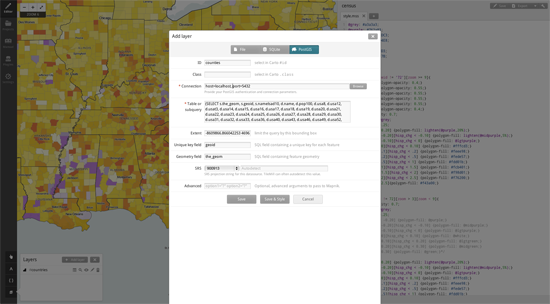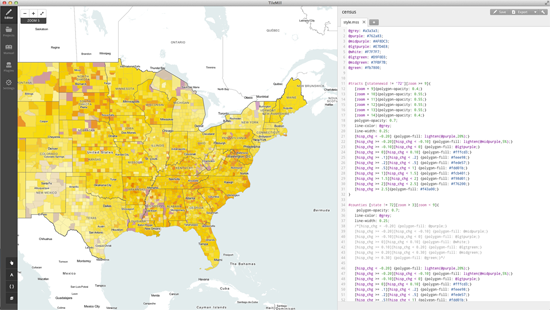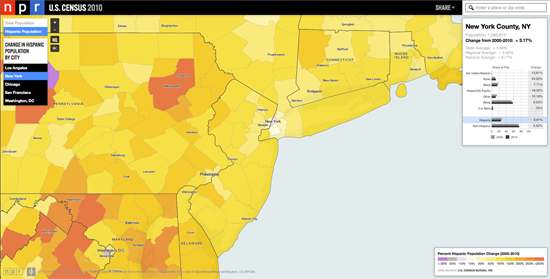Census data was made for mapping, showing the relationship between data points over a geographical area. In 2010, when the decennial census results were released, NPR worked with Development Seed, a data visualization consultancy, to map the changing US Hispanic Population, and in the process, the team may have changed infographics for the better. In the width of a browser, the piece captures a national trend in demographic change, while also illuminating local stories. As news organizations ramp up their data-driven outputs, NPR’s project is worth another look, because it demonstrates how national-level data can be harnessed to tell hyperlocal stories.
The 2010 census figures were released on spreadsheets with millions of rows worth of figures, all available to reporters looking for stories. One of the biggest stories lurking in the numbers was the population change within the Hispanic community. NPR approached Development Seed, and together they came up with the idea to produce a searchable map that showed state-level population change that also drilled down to census tract level information for five major US cities.
NPR outsourced all the data analysis and map-design work to Development Seed, working with the team in the planning stages and providing feedback and input. NPR also produced a series of interviews and news features about cities and locales affected by the population changes to accompany the map. The end result was a comprehensive, color-coded, navigable map that holds a huge amount of information without seeming overwhelming.
Nate Smith, researcher and data lead at Development Seed, who worked on the project, said that a question must always precede data visualization work. Here the issue to be addressed was, “Where is the population changing the US?” Data was downloaded from the US Census Bureau and the Investigators and Editors Census Data website and analyzed in order to find the relevant statistics needed to answer their question.
Nate Smith pulls in information from the database directly to the map. (click image for larger version)
The biggest challenge of this project was coming up with the most appropriate way to visually display all this information on a map. Smith said it was extremely important to be able to hone in on the granular in this piece because NPR wanted to show local level information. The project’s scope was to chart changes within neighborhoods and for users to be able to come to the map and find their own story. Perhaps the most compelling of the map’s features is the function of searching by ZIP code.
Smith used a program called TileMill to create this map. On the right, the code editor window allows him to customize colors and styles. (click image for larger version)
Color played a major role in the design of the map. A gradient moving from purple to green shows total population change, and one from purple to dark orange shows Hispanic population change. Smith said a lot of work went into deciding the color palette; it’s the strongest visual cue on the piece. Color theory and past design experience told Smith that primary colors are best avoided; instead, it was wiser to opt for contrasting colors that nonetheless complemented one another.
The final result. (click image for larger version)
Visualizing data on a scale as large as the census requires narrowing the scope to one engaging focus. NPR and Development Seed’s map found a way to showcase demographic change at a top level, while simultaneously providing a space for individual stories to pop out of the statistics. The decennial census year was one in which NPR mapped out a template for powerful, data-driven reporting.
Anna Codrea-Rado is a digital media associate at the Tow Center for Digital Journalism at the Columbia University Graduate School of Journalism. Follow her on Twitter @annacod.



